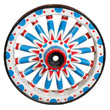Ringling Bros. and Barnum & Bailey Circus Small Ammo Cage # 75
The twelve cage series of small wagons made from former military ordnance trailers were commonly known on the Ringling Bros. and Barnum & Bailey Circus as the “Ammo” cages. While all of them were generally the same with a cleanout side on the back and four folding panels on the front that opened to create a picture frame type wrap on each cage, there were some differences in their designs. 1) The twelve trailers were bought from the Akron Truck and Equipment Co. Built in the Sarasota winter quarters during the winter of 1948 / 1949 out of these four wheeled trailers under the supervision of Bill Yeske, the chassis were fitted with dual tires and the box bodies built on top to create the cage.
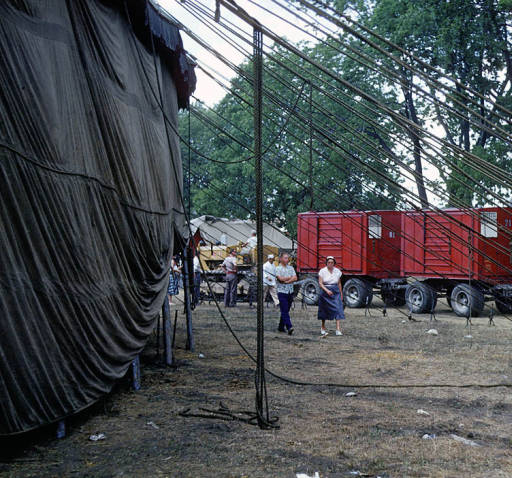 ( 1952 – Sverre Braathen slide taken August 2, 1952 in Columbus, Ohio -Used with permission from Illinois State University’s Special Collections, Milner Library. )
( 1952 – Sverre Braathen slide taken August 2, 1952 in Columbus, Ohio -Used with permission from Illinois State University’s Special Collections, Milner Library. )
The cages were all painted a brilliant Ringling Red for the years 1949, 1950, 1951 and 1952. When the panels were opened up, they presented a jungle motif of leaves, trees and fauna. Cage # 75 would have two vent openings in the front end, one on the right side of center and one on the left side of center. The back end had a slightly larger vent on the left side of center. The former trailers were equipped with an “O” ring on the tongue and a pintle hitch in the back which allowed several of them to be pulled at the same time. There was only one access door on the back of the cage. This cage was used in the menagerie from 1949 to 1956 while still under canvas. The animals that were contained therein changed from year to year and sometimes during the course of the year.
1949 – one Reed Buck and one Anoa Buffalo
1950 – One Reed Buck and one Nyala
1951 – Tapir and Anoa Buffalo
1952 – Unknown
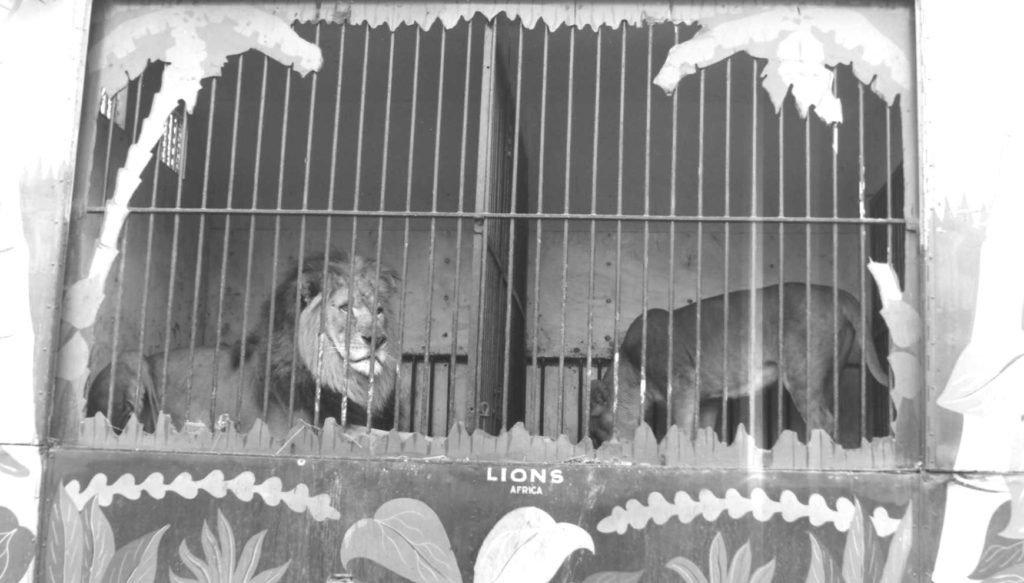 ( 1953 – Richard Cline photo )
( 1953 – Richard Cline photo )
In 1953, the cage bodies were repainted from the bright Ringling Red to a light blue. They still had the jungle motifs on the opening panels. In 1953, Two Lions were carried inside. In 1954, the “Primitive Haitian” designs of Bill Ballantine graced the front panels with many cages carrying various designs. While being multi-colored, very few colored photos have ever shown up of these designs.
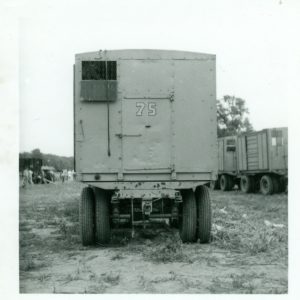 ( 1954 showing the rear door and one vent – Conover Set # 450, photo # 7210 )
( 1954 showing the rear door and one vent – Conover Set # 450, photo # 7210 )
The Bill Ballantine artwork was highly unusual and certainly gave the viewing public something to talk about. In 1954, this cage carried two Guinea Baboons and Green Monkeys. In 1955, the cages were all re-painted again. This time the bodies were dark green with a different jungle motif going back on the opening panels. The cage carried two male lions and two female lions in 1955. Again in 1956, the cage carried Baby Lions.
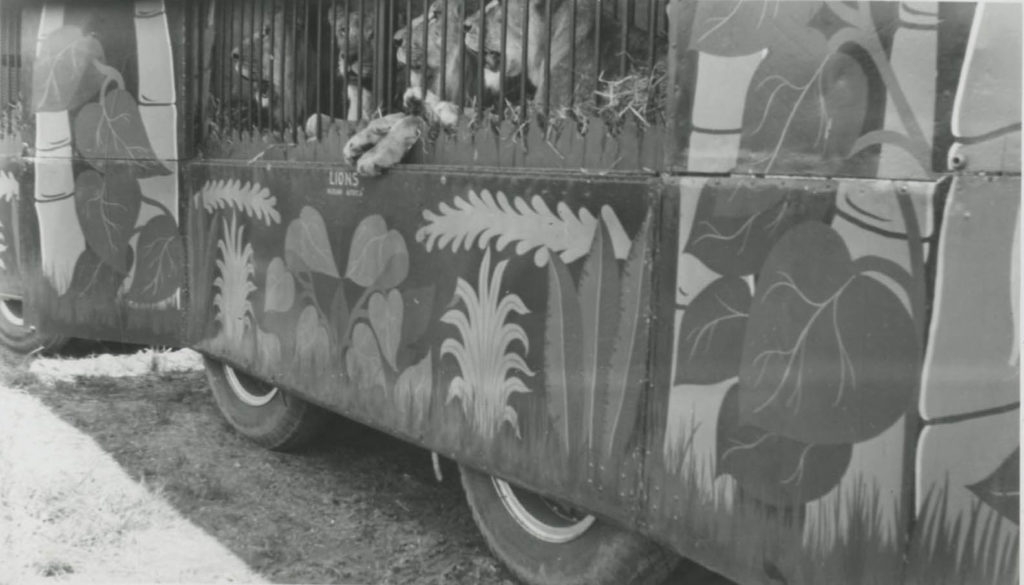 ( 1955 – – Conover Set # 22, photo # 453 – Dyer Reynolds photo )
( 1955 – – Conover Set # 22, photo # 453 – Dyer Reynolds photo )
On July 16, 1956 in Pittsburgh, PA., the Greatest Show on Earth closed for the final time under canvas. The show was returned to the Sarasota winter quarters. Following a re-organization of the show without a big top, the show continued on playing stadiums and ballparks. The menagerie cages were not used. In 1957, the management decided they wanted the menagerie and Side Show acts to appear in Madison Square Garden and then to follow in the Boston Garden. Cage # 72 was part of this display and carried a Tapir. It returned to the Sarasota winter quarters on May 21st, 1957. In 1958, this cage went up to Madison Square Garden as part of the train that took the initial show’s needs north. After playing in the Boston Garden, this cage along with the others was place at the Pawtucket, Rhode island Zoo. When the 1959 season opened, these cages were all brought back to Madison Square Garden but did not go on to the Boston Garden. After their indoor runs, this cage and the others were then taken to a small zoo in New Jersey run by Bob Deitch. The cage then continued the same journey of going to Madison Square Garden then back to Bob Deitch’s Kiddieland Zoo through 1967.
The Ringling Bros. and Barnum & Bailey Circus was sold on Nov. 11, 1967 to a combined ownership of Irvin and Israel Feld and Judge Roy Hofheinz who called Houston, Texas, his home. Judge Hofheinz had a lot of pull with the huge attraction called Astro World which was right beside the stadium the Houston Astros played in. It was his wish to open a circus themed attraction in his brand new Astro World park which opened on June 1, 1968. The new owners took many of the Ringling wagons that were still around out to Houston as preparation for this park to come. Judge Hofheinz sold the Astro World Park to Six Flags in 1975. The Chassis of this wagons was then taken down the street to Texas Salvage on Holmes Road which was just at the end of Kirby Road, the same road that Astro World was on. P. J. Holmes took some pictures at Astro World over the years which he sent to Jim Caldwell. Jim used some of these pictures in his article “Where have all the wagons gone”
By 1980, Texas Salvage had been closed down and cleared out. Where anything went is unknown but it is certain that it was worthless junk.
(1) Dated March 31, 1949 in the Ringling Bros. & Barnum & Bailey Circus Check Register at Circus World Museum
If you have any questions or have more photographic evidence, feel free to contact us at circuswagons@gmail.com
